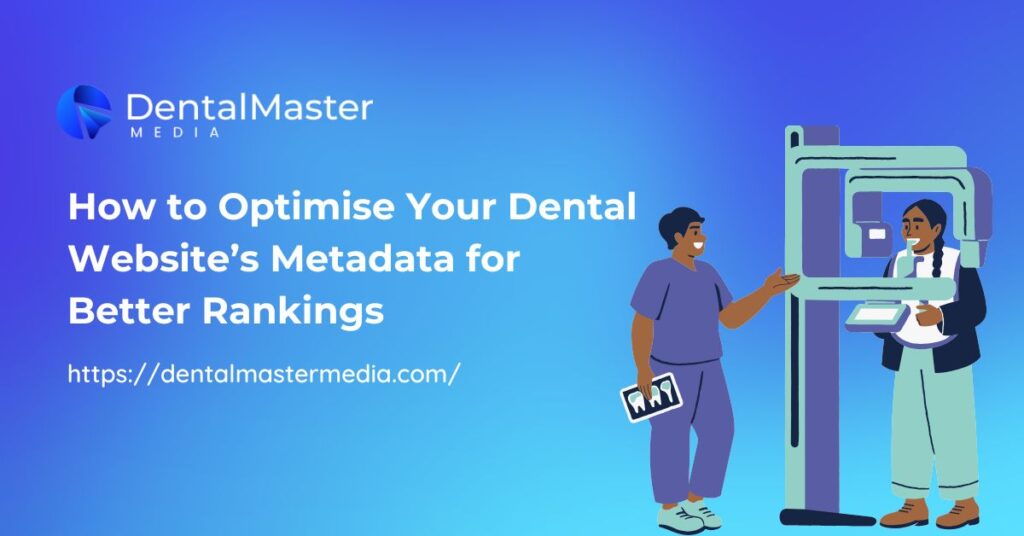In the digital age, having a strong online presence is vital for the success of any dental SEO practice. Your website acts as your virtual front door, welcoming potential patients and providing them with the information they need to choose you over competitors.
While creating engaging content and using eye-catching visuals are important, one of the most crucial — yet often overlooked — aspects of website success is metadata.
Metadata plays a key role in how search engines understand and rank your website. It also influences whether users will actually click through to your site after seeing it in search results. For dental websites looking to improve visibility and attract more patients, optimising metadata is a smart and necessary strategy.
In this article, we’ll explore what metadata is, why it matters, and how you can optimise it to achieve better search engine rankings for your dental practice.
What is Metadata?
Metadata refers to the data that describes other data. In the context of a website, it’s the information embedded in your site’s HTML code that tells search engines what each page is about.
This information doesn’t typically appear on the visible webpage, but it’s incredibly important for SEO (Search Engine Optimization). A Dental SEO Company can help ensure your metadata is properly optimized to improve search visibility and drive more patients to your site.
The three primary types of metadata that affect SEO are:
- Title Tags
- Meta Descriptions
- Meta Keywords (less important today but still worth noting)
Let’s break down each type and see how they impact your dental website’s performance.
1. Title Tags: Your First Impression in Search Results
The title tag is the HTML element that defines the title of a web page. It appears in three key places:
- The browser tab
- Search engine results
- Social media previews
Why It Matters
The title tag is one of the most important on-page SEO factors. A well-crafted title can improve your rankings and increase the chances of users clicking on your listing in search results.
Best Practices for Title Tags
- Keep it concise: Aim for 50–60 characters to avoid being cut off in search results.
- Include your primary keyword: For example, “Affordable Dental Implants | Smile Dental”
- Use your brand name: Add your practice’s name at the end of the title for recognition.
- Be descriptive and compelling: Write titles that make users want to click.
2. Meta Descriptions: Boost Click-Through Rates
A meta description is the short paragraph of text that appears below the title tag in search engine listings. While it doesn’t directly affect rankings, it plays a big role in attracting clicks.
Why It Matters
Think of the meta description as a mini ad for your dental service. A clear, engaging description—especially when crafted with Dental SEO in mind—can persuade users to visit your site instead of a competitor’s.
Best Practices for Meta Descriptions
- Keep it under 160 characters: Avoid truncation in search results.
- Use action-oriented language: Encourage users to “Learn More,” “Book Today,” or “Call Now.”
- Include relevant keywords: Naturally place target keywords like “cosmetic dentist.”
- Match the content: Make sure the description accurately reflects the page’s content.
Example:
“Looking for a trusted family dentist? Our team at Bright Smiles Dental offers personalized, affordable care for all ages. Book an appointment today!”

3. Meta Keywords: Are They Still Relevant?
Meta keywords used to be a standard part of SEO strategy, but they have lost significance over the years. Search engines no longer use them as a ranking factor due to keyword stuffing abuse.
What to Do Instead
Rather than focusing on meta keywords, put more effort into title tags, meta descriptions, headers, and body content. These are more effective areas for keyword optimisation in today’s SEO landscape.
How to Optimise Metadata for Your Dental Website
Now that you understand the types of metadata and why they matter, let’s dive into practical steps to optimise them for your dental practice website.
Step 1: Do Keyword Research
Before you start writing metadata, identify the keywords your potential patients are searching for. Use tools like Google Keyword Planner, Ubersuggest, or Ahrefs to find high-volume, low-competition search terms.
Examples for dental practices might include:
- “Emergency dentist”
- “Teeth whitening near me”
- “Pediatric dentist”
Focus on both general terms and long-tail keywords that reflect the specific services you offer.
Step 2: Write Custom Metadata for Each Page
Avoid using the same title tag and meta description across multiple pages. Each page should have its own unique metadata that reflects the content and target keywords.
For example:
- Homepage Title: “Top-Rated Dentist | Bright Smile Dental”
- Homepage Meta Description: “Bright Smile Dental offers general, cosmetic, and emergency dental care. Call today to schedule your visit.”
- Services Page Title: “Comprehensive Dental Services | Bright Smile Dental”
- Services Page Meta Description: “Explore our full range of dental services including cleanings, implants, veneers, and more — all in a welcoming, modern environment.”
Step 3: Use Local SEO in Your Metadata
Since most dental practices serve a specific geographic area, include your city or neighborhood in your metadata. Even if not explicitly listed here, use placeholders if needed when updating your own site.
Good Example:
“Best Family Dentist | Healthy Smiles Dental Clinic”
Bad Example:
“Welcome to Our Website” (too vague and not optimized)
Local keywords signal to search engines that your practice is relevant for searches made in your area.
Step 4: Test and Monitor Performance
SEO is not a one-and-done task. Regularly review your website’s performance in tools like Google Search Console or SEMrush. See which pages are getting impressions but low click-through rates — this often points to weak metadata.
Update and A/B test different versions of your metadata to see what gets better results. Over time, this can significantly boost your website traffic and new patient inquiries.
Step 5: Stay Updated with Google’s Best Practices
Search engine algorithms are always evolving. What works today may not work tomorrow. Stay informed on best practices and adjust your metadata strategy as needed.
Keep your metadata clean, clear, and free from keyword stuffing. Focus on user experience and clarity above all else.
Common Mistakes to Avoid
Here are some common pitfalls dental websites make with their metadata:
- Duplicate Metadata: Using the same title or description on every page confuses search engines and limits visibility.
- Missing Metadata: Pages without title tags or meta descriptions may be ignored or poorly ranked.
- Overuse of Keywords: Keyword stuffing looks spammy and can hurt rankings.
- Too Long or Too Short: Metadata that gets cut off or is too vague won’t perform well.
- Not Matching the Page Content: Misleading metadata frustrates users and increases bounce rates.
How Metadata Enhances Your SEO Strategy
Metadata alone won’t guarantee top rankings, but it’s a foundational element of a broader strategy for SEO dental . Combined with fast loading speeds, mobile optimization, quality content, and backlinks, well-optimized metadata sets the stage for success.
For dentists who are just starting to build their digital footprint, focusing on metadata is a simple but effective first step in attracting more local patients online.
If you’re investing time or money in digital marketing, you want to make sure all the technical elements of your website are dialed in — and that begins with your metadata.
Conclusion
Optimising your dental website’s metadata is a small task with a big impact. It helps search engines understand what your site is about and increases the chances of users clicking on your link in search results.
Title tags and meta descriptions are powerful tools that, when written thoughtfully and strategically, can set your practice apart from the competition.
Start by conducting keyword research relevant to your dental services. Then write unique, keyword-rich metadata for every page on your site. Monitor performance regularly and update as needed to stay ahead in search rankings.
Whether you’re running a general dentistry practice, an orthodontics clinic, or a cosmetic dental studio, effective metadata optimisation is an essential component of SEO for Dentists.
And remember — improving your metadata is not just about search engines. It’s about creating a better, more informative experience for your future patients. With the right strategy, SEO for Dentists becomes a gateway to lasting online visibility and practice growth.

Suraj Rana is the owner of Dental Master Media and a leading expert in SEO for dental practices. With a passion for dental marketing, he has successfully helped numerous dental clinics climb the search engine ranks. Suraj’s expertise makes him a go-to resource for effective, results-driven dental marketing.

